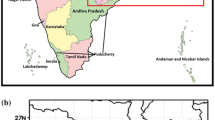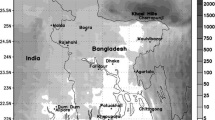Abstract
This paper demonstrates the usefulness of Indian Doppler Weather Radar (DWR) data for nowcasting applications, and assimilation into a mesoscale Numerical Weather Prediction (NWP) model. Warning Decision Support System Integrated Information (WDSS-II) developed by National Severe Storm Laboratory (NSSL) and Advanced Regional Prediction System (ARPS) developed at the Centre for Analysis and Prediction, University of Oklahoma are used for this purpose. The study reveals that the WDSS-II software is capable of detecting and removing anomalous propagation echoes from the Indian DWR data. The software can be used to track storm cells and mesocyclones through successive scans. Radar reflectivity mosaics are created for a land-falling tropical cyclone—Khaimuk of 14 November 2008 over the Bay of Bengal using observations from three DWR stations, namely, Visakhapatnam, Machilipatnam and Chennai. Assimilation of the quality-controlled radar data (DWR, Chennai) of the WDSS-II software in a very high-resolution NWP model (ARPS) has a positive impact for improving mesoscale prediction. This has been demonstrated for a land-falling tropical cyclone Nisha of 27 November 2008 of Tamil Nadu coast. This paper also discusses the optimum scan strategy and networking considerations. This work illustrates an important step of transforming research to operation.















Similar content being viewed by others
References
Cressman G (1959) An operational objective analysis scheme. Mon Weather Rev 87:367–374
Eilts MD, Smith SD (1990) Efficient dealiasing of Doppler velocities using local environment constraints. J Atmos Ocean Technol 7:118–128
Heinselman PL, Priegnitz DL, Manross KL, Smith TM, Adams RW (2008) Rapid sampling of severe storms by the National Weather Radar Test bed Phased Array Radar. Weather Forecast 23:808–824
Johnson J, Mackeen P, Witt A, Mitchell E, Stumpf G, Eilts M, Thomas K (1998) The storm cell identification and tracking algorithm: an enhanced WSR-88D algorithm. Weather Forecast 13:263–276
Koch SE, Ferrier B, Stolinga M, Szoke E, Weiss SJ, Kain JS (2005) The use of simulated radar reflectivity fields in the diagnosis of mesoscale phenomena from high resolution WRF model. In: Proceedings of 11th conference on mesoscale processes, American Meteorological Society, Albuquerque, NM, CD ROM J4J7
Lakshmanan V, Rabin R, DeBrunner V (2003) Multiscale storm identification and forecast. J Atmos Res 67:367–380
Lakshmanan V, Smith T, Hondl KD, Stumpf G, Witt A (2006) A real-time, three-dimensional, rapidly updating, heterogeneous radar merger technique for reflectivity, velocity, and derived products. Weather Forecast 21(5):802–823
Lakshmanan V, Smith T, Stumpf G, Hondl KD (2007a) The warning decision support system integrated information. Weather Forecast 22:596–612
Lakshmanan V, Fritz A, Smith T, Hondl K, Stumpf G (2007b) An automated technique to quality control radar reflectivity data. J Appl Meteorol Climatol 46(3):288–305
Lynn R, Lakshmanan V (2002) Virtual radar volumes: creation, algorithm access and visualization. In: Proceedings of 21st conference on severe local storms, American Meteorological Society, San Antonio, TX
Sen Roy S, Lakshmanan V, Roy Bhowmik SK, Thampi SB (2010) Doppler weather radar based nowcasting of Cyclone Ogni. J Earth Syst Sci 119:183–200
Smith TM, Elmore KL (2004) The use of radial velocity derivatives to diagnose rotation and divergence. In: Proceedings of 11th conference on aviation, range, and aerospace, American Meteorological Society, Hyannis, MA, CD-ROM
Stumpf GJ, Smith TM, Gerard AE (2002) The multiple-radar severe storm analysis program (MR-SSAP) for WDSS-II. In: Proceedings of 21st conference on severe local storms, American Meteorological Society, San Antonio, TX, pp 138–141
Xue M, Wang D, Gao J, Brewster K, Droegemeier KK (2003) The Advanced Regional Prediction System (ARPS) storm scale numerical weather prediction and data assimilation. Meteorol Atmos Phys 82:139–170
Zhang J, Wang S (2006) An automated 2D multipass Doppler radar velocity dealiasing scheme. J Atmos Ocean Technol 23(9):1239–1248
Zhang J, Gourley JJ, Howard K, Maddox B (2001) Threedimensional gridding and mosaic of reflectivities from multiple WSR-88D radars. In: Proceedings of 30th international conference on radar meteorology
Acknowledgments
The study was initiated as a part of US Agency of International Development (USAID) supported collaborative sub project “Local Severe Storm” with National Severe Storm Lab and the Oklahoma University of USA. Authors like to thank Dr. V. Lakshmanan and Dr. Ming Xue of the University of Oklahoma for the technical support. We thankfully acknowledge the National Severe Storm Laboratory, USA for the use of Application software WDSS-II and the University of Oklahoma for using the ARPS model. Authors are grateful to AVM (Dr.) Ajit Tyagi, Director General of Meteorology for his keen interest, encouragement, valuable suggestions and providing all facilities to carry out this work. Authors are also thankful to Mr. R.C. Bhatia, Retired Additional Director General of Meteorology and Mr. A.K. Bhatnagar, Additional Director General of Meteorology of India Meteorological Department, New Delhi for guidance, suggestions and support.
Author information
Authors and Affiliations
Corresponding author
Rights and permissions
About this article
Cite this article
Roy Bhowmik, S.K., Sen Roy, S., Srivastava, K. et al. Processing of Indian Doppler Weather Radar data for mesoscale applications. Meteorol Atmos Phys 111, 133–147 (2011). https://doi.org/10.1007/s00703-010-0120-x
Received:
Accepted:
Published:
Issue Date:
DOI: https://doi.org/10.1007/s00703-010-0120-x




